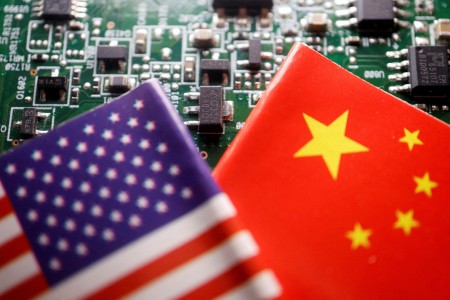BEIJING (Reuters) – Shares in several Chinese companies linked to the semiconductor industry surged on Wednesday, driven by investor excitement over a government list that some interpret as signaling progress in China’s efforts to develop domestic chipmaking technology.
Shanghai Zhangjiang Hi-Tech Park Development and Shanghai Highly Group both hit their daily limit of 10% gains by market close. Sanhe Tongfei Refrigeration , which has a wider trading band, reached its 20% daily limit.
Shenyang Blue Silver Industry Automation Equipment ended the day up 10.7%.
The surge follows a Sept. 9 release by China’s Ministry of Industry and Information Technology (MIIT) of a guide promoting the use of major domestic technical equipment.
The MIIT guide specifically mentioned two lithography machine models and recommended their use by state-linked organizations.
Chipmaking tools have become a focal point in China’s push to develop its domestic semiconductor industry. This sector has faced significant challenges due to U.S. and allied restrictions on exporting advanced equipment to China, part of ongoing efforts to limit Beijing’s technological advancement.
ASML, a Dutch firm and one of the few global manufacturers of advanced lithography machines, has been barred from selling its most sophisticated equipment to China.
Chinese companies, including Shanghai Micro Electronics Equipment (SMEE), have been actively developing domestic lithography capabilities.
However, industry experts say progress has been limited, underscoring the technological challenges China faces in this sector.
The more advanced of the two lithography machines mentioned in the list, for which MIIT did not specify a supplier, has a resolution of 65 nanometers or better.
Resolution determines how small the features on a semiconductor chip can be made. Smaller resolutions allow for more advanced, powerful chips.
For comparison, ASML’s most advanced lithography machines currently achieve resolutions of 8 nanometers and less.
The 65-nanometer resolution machine mentioned in the MIIT list lags behind international competitors by at least 15 years, according to Leslie Wu, chief executive of consulting firm RHCC.
(Reporting by Beijing newsroom; Editing by Keith Weir)











